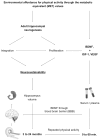Environmental Affordance for Physical Activity, Neurosustainability, and Brain Health: Quantifying the Built Environment's Ability to Sustain BDNF Release by Reaching Metabolic Equivalents (METs)
- PMID: 39595896
- PMCID: PMC11592236
- DOI: 10.3390/brainsci14111133
Environmental Affordance for Physical Activity, Neurosustainability, and Brain Health: Quantifying the Built Environment's Ability to Sustain BDNF Release by Reaching Metabolic Equivalents (METs)
Abstract
Background/Objectives: Unlike enriched environments for rodents, human-built environments often hinder neuroplasticity through sedentary lifestyles, to which exercise can merely overcome its adverse effects. This paper introduces "environmental affordance for physical activity" to quantify the potential of spatial layout designs to stimulate activity and sustain neuroplasticity, mainly hippocampal neurogenesis. Methods: A novel framework links metabolic equivalents (METs) that can be afforded by the spatial layout of the built environment to its role in increasing the brain-derived neurotrophic factor (BDNF)-a biomarker that promotes and sustains adult hippocampal neurogenesis and synaptic plasticity. Equations are developed to assess the built environment's affordance for physical activity through BDNF changes measurable after brief exposure to the built environment for 20-35 min. Results: The developed equations are evidenced to be feasible to cause BDNF release through low- to moderate-intensity physical activity. This model provides a feasible assessment tool to test the built environment's effectiveness towards neurosustainability. Conclusions: By sustaining neurogenesis, the environmental affordance for physical activity holds promise for improving mental health and preventing cognitive decline.
Keywords: architectural design; brain health and cognition; built environment; environmental enrichment; exercise; neuroplasticity; spatial layout.
Conflict of interest statement
The authors declare no conflict of interest.
Figures





References
-
- de Sousa Fernandes M.S., Ordônio T.F., Santos G.C.J., Santos L.E.R., Calazans C.T., Gomes D.A., Santos T.M. Effects of physical exercise on neuroplasticity and brain function: A systematic review in human and animal studies. Neural Plast. 2020;2020:8856621. doi: 10.1155/2020/8856621. - DOI - PMC - PubMed
-
- Lauretta G., Ravalli S., Maugeri G., D’Agata V., Rosa M.D., Musumeci G. The impact of physical exercise on the hippocampus in physiological condition and ageing-related decline: Current evidence from animal and human studies. Curr. Pharm. Biotechnol. 2022;23:180–189. doi: 10.2174/1389201022666210405142611. - DOI - PubMed
-
- Håkansson K., Ledreux A., Daffner K., Terjestam Y., Bergman P., Carlsson R., Mohammed A.K.H. BDNF responses in healthy older persons to 35 minutes of physical exercise, cognitive training, and mindfulness: Associations with working memory function. J. Alzheimer’s Dis. 2017;55:645–657. doi: 10.3233/JAD-160593. - DOI - PMC - PubMed
Grants and funding
LinkOut - more resources
Full Text Sources
Medical

